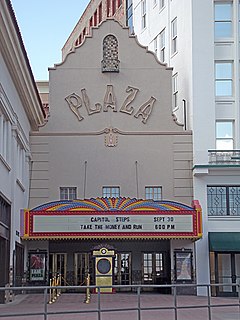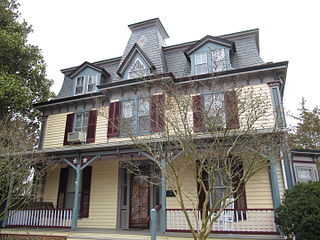
Worcester County is the easternmost county of the U.S. state of Maryland. As of the 2010 census, the population was 51,454. Its county seat is Snow Hill. It is the only county of Maryland that borders the Atlantic Ocean, and the only county bordering both Delaware and Virginia. The county was named for Mary Arundell, the wife of Sir John Somerset, a son of Henry Somerset, 1st Marquess of Worcester. She was sister to Anne Arundell, wife of Cecil Calvert, 2nd Baron Baltimore, the first Proprietor and Proprietary Governor of the Province of Maryland.

Pocomoke City, dubbed "the friendliest town on the Eastern Shore", is a city in Worcester County, Maryland, United States. Although renamed in a burst of civic enthusiasm in 1878, the city is regularly referred to by its inhabitants simply as Pocomoke. The population was 4,184 at the 2010 census. It is part of the Salisbury, Maryland-Delaware Metropolitan Statistical Area. Pocomoke City is a center for commerce on the lower shore, home to an industrial park currently playing host to defense contractors, aerospace engineering, and plastics fabrication. Pocomoke City is located near the Wallops Island Flight Facility in Wallops Island, Virginia.
U.S. Route 113 (US 113) is a U.S. Highway that is a spur of US 13 in the U.S. states of Maryland and Delaware. The route runs 74.75 miles (120.30 km) from US 13 in Pocomoke City, Maryland north to Delaware Route 1 (DE 1) in Milford, Delaware. In conjunction with DE 1, US 113 is one of two major north–south highways on the Delmarva Peninsula that connect Dover with Pocomoke City and the Eastern Shore of Virginia. The U.S. Highway is the primary north–south highway in Worcester County, Maryland, where it connects Pocomoke City with Snow Hill and Berlin. US 113 is one of three major north–south highways in Sussex County, Delaware, where it connects Selbyville, Millsboro, and Georgetown with Milford. While US 113 does not pass through Ocean City or the Delaware Beaches, the U.S. Highway intersects several highways that serve the Atlantic seaboard resorts, including US 50, Maryland Route 90 (MD 90), US 9, DE 404, and DE 1. US 113 is a four-lane divided highway for its whole length.

The Fox Theatre is a performing arts center located at 2211 Woodward Avenue in Downtown Detroit, Michigan, near the Grand Circus Park Historic District. Opened in 1928 as a flagship movie palace in the Fox Theatres chain, it was at over 5,000 seats the largest theater in the city. Designed by theater architect C. Howard Crane, it was listed on the National Register of Historic Places in 1985 and was designated a National Historic Landmark in 1989 for its architecture. The area surrounding the Fox is nicknamed Foxtown. The city's major performance centers and theatres emanate from the Fox Theatre and Grand Circus Park Historic District and continue along Woodward Avenue toward the Fisher Theatre in the city's New Center.

The Byrd Theatre is a cinema in the Carytown neighborhood of Richmond, Virginia. It was named after William Byrd II, the founder of the city. The theater opened on December 24, 1928 to much excitement and is affectionately referred to as "Richmond’s Movie Palace". It was the first cinema in Virginia to be outfitted when built with a sound system.

The Chateau Theatre originally opened as a Vaudeville house in Rochester, Minnesota, in 1927 with an interior decorated as a medieval village. The theater was converted to a movie house eventually remodeled and reopened as a Barnes & Noble bookstore. The Chateau was originally opened on October 26, 1927. The architects, Ellerbe, said," We have given this town the finest theater of its size, bar none, in the U.S."

Huntridge Theater sometimes known as the Huntridge Performing Arts Theater is a Streamline Moderne building located in Las Vegas, Nevada, that is listed on the United States National Register of Historic Places. The building was designed by S. Charles Lee.

Orpheum Theatre is a theater located in downtown Minneapolis, Minnesota. It is one of four restored theaters on Hennepin Avenue, along with the Pantages Theatre, the State Theatre and the Shubert Theatre.

Saenger Theatre is an atmospheric theatre in downtown New Orleans, Louisiana, which is on the National Register of Historic Places. Once the flagship of Julian and Abe Saenger's theatre empire, today it is one of only a handful of Saenger movie palaces that remain.

The Plaza Theatre is a historic building in El Paso, Texas built in 1930. The theater stands as one of the city's most well-known landmarks, and remains operational today. The theatre is a National Historic Building of Significance featuring the 2,050-seat Kendall Kidd Performance Hall, and the smaller 200-seat Philanthropy Theatre. It hosts Broadway productions, musical concerts, individual performers and the annual Plaza Classic Film Festival.

The Temple Theatre is an historic performance center in Sanford, Lee County, North Carolina. The Temple Theatre was built in 1925 by Robert Ingram, Sr., at a time when Sanford had a population of only 3,500. The name "Temple" comes from being located next door to what was once Sanford's Masonic Lodge. The following quote ran in a 1925 issue of the Sanford Express, "In erecting this modern theater, he has spared no expense to make it an up-to-date playhouse." It is a 50 feet wide-by-92 feet deep, two-story, brick building decorated with cut stone details in a blend of Colonial Revival and Art Deco styles.

The Costen House is a historic U.S. home located at 206 Market Street, Pocomoke City, Maryland, United States. Dr. Isaac Thomas Costen built the house c. 1870s and members of his family lived there for over a century. Dr. Costen became the first Mayor of Pocomoke City. The house currently serves as The Isaac Costen House Museum.

Beverly is a historic home located in Pocomoke City, Worcester County, Maryland, United States. It is a 2+1⁄2-story, Georgian-style Flemish bond brick house built about 1770. The house faces the Pocomoke River. An original circular ice house survives on the property.

The Littleton T. Clarke House is a historic home located at Pocomoke City, Worcester County, Maryland, United States. It is a 2+1⁄2-story Second Empire–style frame house with a concave curved mansard roof constructed about 1860.

Crockett House is a historic home located at Pocomoke City, Worcester County, Maryland, United States. The house is a two-story center passage plan frame dwelling, constructed about 1850, that reflects the influence of the Greek Revival style. Attached is a stepped "telescope" service wing.

The Young-Sartorius House is a historic home located at Pocomoke City, Worcester County, Maryland. It is a 2+1⁄2-story, center-passage / single-pile frame dwelling built in two stages between about 1860 and about 1900.

The Pocomoke City Historic District is a national historic district in Pocomoke City, Worcester County, Maryland. The historic district includes the central business district (CBD) and surrounding residential area of Pocomoke City. The CBD is defined by an important collection of late-19th century and early-20th century commercial and public architecture. It includes a significant array of Victorian, Colonial Revival, and Beaux-Arts influenced structures. The majority of the housing dates from 1870 to 1940. It is an example of a type of prosperous river town that characterized the region during the period, which retains an exceptional collection of 19th and 20th century building forms.

The Oriental Theatre was a movie theater located at 828 SE Grand Street in the East Portland commercial district of Portland, Oregon. Built in 1927, the Oriental was a 2,038-seat movie palace designed by Lee Arden Thomas and Albert Mercier. The building's exterior was in the Italian Renaissance style. The interior had an "almost surreal appearance" created by interior designer Adrien Alex Voisin. It was built by George Warren Weatherly. Demolished in 1970, the theater was adjacent to the Weatherly Building, which remains standing.

The Brauntex Theatre is a former movie palace located in downtown New Braunfels in the U.S. state of Texas. It was built in the late Art Deco period in 1942. It is listed on the National Register of Historic Places.

The Baltimore, Chesapeake and Atlantic railroad, nicknamed Black Cinders & Ashes, ran from Baltimore, Maryland to Ocean City, Maryland consisting of 87 miles (140.0 km) of center-line track and 15.6 miles (25.11 km) of sidings. Chartered in 1886, the railroad started construction in 1889 and cost $2.356 million ($2022=67,862,000).























